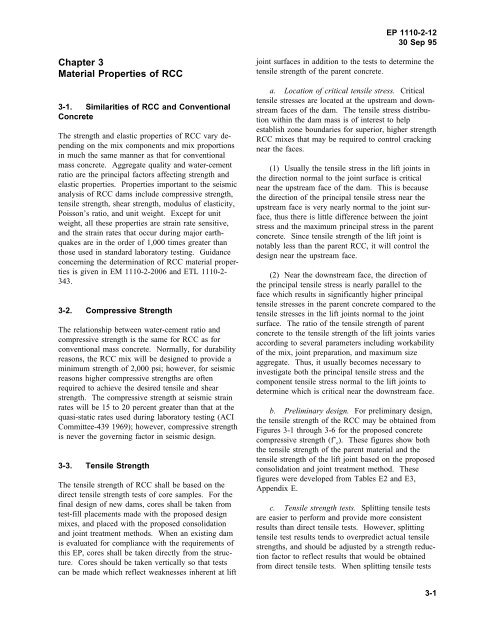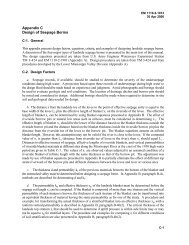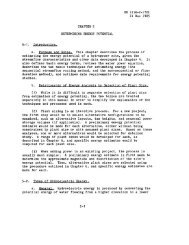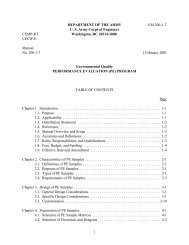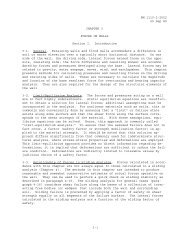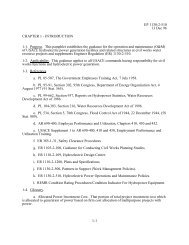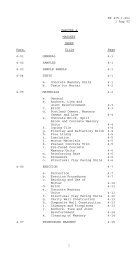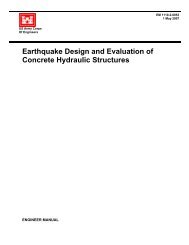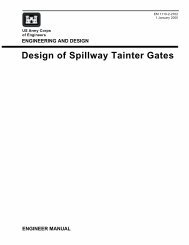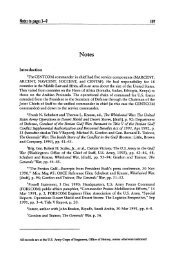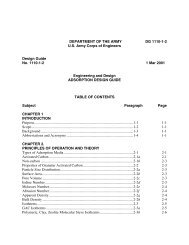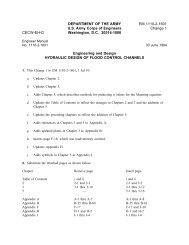Chapter 3 Material Properties of RCC
Chapter 3 Material Properties of RCC
Chapter 3 Material Properties of RCC
Create successful ePaper yourself
Turn your PDF publications into a flip-book with our unique Google optimized e-Paper software.
<strong>Chapter</strong> 3<br />
<strong>Material</strong> <strong>Properties</strong> <strong>of</strong> <strong>RCC</strong><br />
3-1. Similarities <strong>of</strong> <strong>RCC</strong> and Conventional<br />
Concrete<br />
The strength and elastic properties <strong>of</strong> <strong>RCC</strong> vary depending<br />
on the mix components and mix proportions<br />
in much the same manner as that for conventional<br />
mass concrete. Aggregate quality and water-cement<br />
ratio are the principal factors affecting strength and<br />
elastic properties. <strong>Properties</strong> important to the seismic<br />
analysis <strong>of</strong> <strong>RCC</strong> dams include compressive strength,<br />
tensile strength, shear strength, modulus <strong>of</strong> elasticity,<br />
Poisson’s ratio, and unit weight. Except for unit<br />
weight, all these properties are strain rate sensitive,<br />
and the strain rates that occur during major earthquakes<br />
are in the order <strong>of</strong> 1,000 times greater than<br />
those used in standard laboratory testing. Guidance<br />
concerning the determination <strong>of</strong> <strong>RCC</strong> material properties<br />
is given in EM 1110-2-2006 and ETL 1110-2-<br />
343.<br />
3-2. Compressive Strength<br />
The relationship between water-cement ratio and<br />
compressive strength is the same for <strong>RCC</strong> as for<br />
conventional mass concrete. Normally, for durability<br />
reasons, the <strong>RCC</strong> mix will be designed to provide a<br />
minimum strength <strong>of</strong> 2,000 psi; however, for seismic<br />
reasons higher compressive strengths are <strong>of</strong>ten<br />
required to achieve the desired tensile and shear<br />
strength. The compressive strength at seismic strain<br />
rates will be 15 to 20 percent greater than that at the<br />
quasi-static rates used during laboratory testing (ACI<br />
Committee-439 1969); however, compressive strength<br />
is never the governing factor in seismic design.<br />
3-3. Tensile Strength<br />
The tensile strength <strong>of</strong> <strong>RCC</strong> shall be based on the<br />
direct tensile strength tests <strong>of</strong> core samples. For the<br />
final design <strong>of</strong> new dams, cores shall be taken from<br />
test-fill placements made with the proposed design<br />
mixes, and placed with the proposed consolidation<br />
and joint treatment methods. When an existing dam<br />
is evaluated for compliance with the requirements <strong>of</strong><br />
this EP, cores shall be taken directly from the structure.<br />
Cores should be taken vertically so that tests<br />
can be made which reflect weaknesses inherent at lift<br />
EP 1110-2-12<br />
30 Sep 95<br />
joint surfaces in addition to the tests to determine the<br />
tensile strength <strong>of</strong> the parent concrete.<br />
a. Location <strong>of</strong> critical tensile stress. Critical<br />
tensile stresses are located at the upstream and downstream<br />
faces <strong>of</strong> the dam. The tensile stress distribution<br />
within the dam mass is <strong>of</strong> interest to help<br />
establish zone boundaries for superior, higher strength<br />
<strong>RCC</strong> mixes that may be required to control cracking<br />
near the faces.<br />
(1) Usually the tensile stress in the lift joints in<br />
the direction normal to the joint surface is critical<br />
near the upstream face <strong>of</strong> the dam. This is because<br />
the direction <strong>of</strong> the principal tensile stress near the<br />
upstream face is very nearly normal to the joint surface,<br />
thus there is little difference between the joint<br />
stress and the maximum principal stress in the parent<br />
concrete. Since tensile strength <strong>of</strong> the lift joint is<br />
notably less than the parent <strong>RCC</strong>, it will control the<br />
design near the upstream face.<br />
(2) Near the downstream face, the direction <strong>of</strong><br />
the principal tensile stress is nearly parallel to the<br />
face which results in significantly higher principal<br />
tensile stresses in the parent concrete compared to the<br />
tensile stresses in the lift joints normal to the joint<br />
surface. The ratio <strong>of</strong> the tensile strength <strong>of</strong> parent<br />
concrete to the tensile strength <strong>of</strong> the lift joints varies<br />
according to several parameters including workability<br />
<strong>of</strong> the mix, joint preparation, and maximum size<br />
aggregate. Thus, it usually becomes necessary to<br />
investigate both the principal tensile stress and the<br />
component tensile stress normal to the lift joints to<br />
determine which is critical near the downstream face.<br />
b. Preliminary design. For preliminary design,<br />
the tensile strength <strong>of</strong> the <strong>RCC</strong> may be obtained from<br />
Figures 3-1 through 3-6 for the proposed concrete<br />
compressive strength (f’ c). These figures show both<br />
the tensile strength <strong>of</strong> the parent material and the<br />
tensile strength <strong>of</strong> the lift joint based on the proposed<br />
consolidation and joint treatment method. These<br />
figures were developed from Tables E2 and E3,<br />
Appendix E.<br />
c. Tensile strength tests. Splitting tensile tests<br />
are easier to perform and provide more consistent<br />
results than direct tensile tests. However, splitting<br />
tensile test results tends to overpredict actual tensile<br />
strengths, and should be adjusted by a strength reduction<br />
factor to reflect results that would be obtained<br />
from direct tensile tests. When splitting tensile tests<br />
3-1
EP 1110-2-12<br />
30 Sep 95<br />
Figure 3-1. Tensile strength range, <strong>RCC</strong>, MSA ≤ 1.5 inches, consistency < 30 seconds vibration, mortar<br />
bedding<br />
are used as the basis for determining the tensile<br />
strength <strong>of</strong> <strong>RCC</strong>, the test results shall be reduced by a<br />
strength reduction factor <strong>of</strong> 75 percent as recommended<br />
in Appendix E.<br />
d. Factors affecting tensile strength. The tensile<br />
strength <strong>of</strong> <strong>RCC</strong>, as well as <strong>of</strong> conventionally placed<br />
mass concrete, is dependent on many variables<br />
including paste and aggregate strength, aggregate size,<br />
loading history, and load deformation rates. See<br />
paragraph 3-9 concerning strain rate sensitivity and<br />
dynamic tensile strength.<br />
(1) <strong>RCC</strong> differs from conventionally placed mass<br />
concrete due to the many horizontal planes <strong>of</strong> weakness<br />
(construction joints) created during placement.<br />
<strong>RCC</strong> is placed and compacted in layers ranging from<br />
6 to 24 inches with each layer creating a joint with<br />
tensile strength less than that <strong>of</strong> the parent concrete.<br />
3-2<br />
The joint strength can be improved by placing a layer<br />
<strong>of</strong> high slump bedding mortar on each lift; however,<br />
the resulting joint strength is always somewhat less<br />
than the parent concrete. The consistency <strong>of</strong> <strong>RCC</strong><br />
can also affect tensile strength with lower strength<br />
values for harsh mixes with low paste contents.<br />
Refer to <strong>Chapter</strong> 2 for additional discussion <strong>of</strong> these<br />
factors.<br />
(2) Inherent in some <strong>RCC</strong> mixes are certain<br />
anisotropic material properties. In the <strong>RCC</strong> compaction<br />
process, the flatter coarse aggregate particles in<br />
these mixes have a tendency to align themselves in<br />
the horizontal direction. When this occurs, the<br />
strength <strong>of</strong> vertical cores will be less, and the strength<br />
<strong>of</strong> horizontal cores greater than the average tensile<br />
strength. The variance from average could be as high<br />
as 20 percent, although in general these effects will
EP 1110-2-12<br />
30 Sep 95<br />
Figure 3-2. Tensile strength range, <strong>RCC</strong>, MSA > 1.5 inches, consistency < 30 seconds vibration, mortar<br />
bedding<br />
be small. If the coarse aggregate particle shape indicates<br />
the possibility <strong>of</strong> significant anisotropy, both<br />
vertical and horizontal cores obtained from the laboratory<br />
test placement should be tested.<br />
3-4. Shear Strength<br />
The shear strength along lift joint surfaces is always<br />
less than the parent concrete; therefore, final shear<br />
strength determination should be based on tests <strong>of</strong><br />
representative samples from the dam or test fill.<br />
Both the bond strength and the tangent <strong>of</strong> the angle<br />
<strong>of</strong> internal friction can be increased by 10 percent to<br />
account for the apparent higher strengths associated<br />
with seismic strain rates.<br />
3-5. Modulus <strong>of</strong> Elasticity<br />
<strong>RCC</strong> will usually provide a modulus <strong>of</strong> elasticity<br />
equal to, or greater than, that <strong>of</strong> conventional mass<br />
concrete <strong>of</strong> equal compressive strength. The modulus<br />
<strong>of</strong> <strong>RCC</strong> in tension is equal to that in compression.<br />
The static modulus <strong>of</strong> elasticity, in the absence <strong>of</strong><br />
testing, can be assumed equal to (ACI Committee-207<br />
1973):<br />
E 57,000 f c<br />
where E static modulus <strong>of</strong> elasticity<br />
f c<br />
static compressive strength <strong>of</strong> <strong>RCC</strong><br />
3-3
EP 1110-2-12<br />
30 Sep 95<br />
Figure 3-3. Tensile strength range, <strong>RCC</strong>, MSA ≤ 1.5 inches, consistency > 30 seconds vibration, mortar<br />
bedding<br />
The relationship between strain rate and modulus <strong>of</strong><br />
elasticity is as follows (Bruhwieler 1990):<br />
E E(E r ) 0.020<br />
where E static modulus <strong>of</strong> elasticity<br />
E seismic modulus <strong>of</strong> elasticity at the<br />
quasi static rate<br />
E r<br />
high seismic strain rate<br />
quasi static rate<br />
For a seismic strain rate equal to 1,000 times the<br />
quasi-static rate the seismic modulus <strong>of</strong> elasticity is<br />
1.15 times the static modulus. For long-term loadings<br />
where creep effects are important, the effective<br />
modulus <strong>of</strong> elasticity may be only 2/3 the static mod-<br />
3-4<br />
ulus <strong>of</strong> elasticity calculated by the above formula<br />
(Dunstan 1978). The modulus <strong>of</strong> elasticity may<br />
exhibit some anisotropic behavior due to the coarse<br />
aggregate particle alignment as discussed in<br />
paragraph 3-3d(2); however, the effects on the<br />
modulus will be small and can be disregarded when<br />
performing a dynamic stress analysis.<br />
3-6. Poisson’s Ratio<br />
Poisson’s ratio for <strong>RCC</strong> is the same as for conventional<br />
mass concrete. For static loads, values range<br />
between 0.17 and 0.22, with 0.20 recommended when<br />
testing has not been performed. Poisson’s ratio is also<br />
strain rate sensitive, and the static value should be<br />
reduced by 30 percent when evaluating stresses due<br />
to seismic loads (Bruhwieler 1990).
3-7. Tensile Stress/Strain Relationship<br />
EP 1110-2-12<br />
30 Sep 95<br />
Figure 3-4. Tensile strength range, <strong>RCC</strong>, MSA > 1.5 inches, consistency > 30 seconds vibration, mortar<br />
bedding<br />
As mentioned in paragraph 2-2b, concrete cracking,<br />
crack propagation, and the energy dissipated in the<br />
process are complex and nonlinear in nature. For a<br />
simplified linear-elastic analysis, a constant modulus<br />
<strong>of</strong> elasticity is required. Thus, a linear stress/strain<br />
relationship is used for the analysis with a tensile<br />
modulus equal to the modulus <strong>of</strong> elasticity for concrete<br />
in compression.<br />
a. Compression and tension differences.<br />
Although a linear relationship is assumed for the<br />
analysis, in actuality the stress/strain relationship<br />
becomes nonlinear after concrete stresses reach<br />
approximately 60 percent <strong>of</strong> the peak stress (Raphael<br />
1984). In compression this does not cause a problem<br />
because, in general, concrete compressive stresses<br />
even during a major earthquake are quite low with<br />
respect to the peak stress or ultimate capacity. In<br />
tension, it is a different matter since tensile stress can<br />
approach and exceed the peak tensile stress capacity<br />
<strong>of</strong> the concrete and in some cases cracking will<br />
occur.<br />
b. Tensile stress/strain curve. The actual nonlinear<br />
stress/strain relationship for <strong>RCC</strong> concrete is<br />
shown in Figure 3-7. The assumed linear relationship<br />
used for finite element analysis was developed from<br />
the work done by Raphael (1984). The actual nonlinear<br />
performance <strong>of</strong> concrete in tension consists <strong>of</strong> a<br />
linear region from zero stress up to 60 percent <strong>of</strong> the<br />
peak stress, a nonlinear ascending region from<br />
60 percent <strong>of</strong> peak stress to peak stress (this point on<br />
the curve corresponds to the direct tensile strength<br />
test value described in paragraph 3-3c), and a nonlinear<br />
descending region from peak stress back to zero<br />
3-5
EP 1110-2-12<br />
30 Sep 95<br />
Figure 3-5. Tensile strength range, <strong>RCC</strong>, MSA ≤ 1.5 inches, consistency > 30 seconds vibration, no mortar<br />
bedding<br />
stress. The last region is termed the “tensile s<strong>of</strong>tening<br />
zone.” In this region, where deformation<br />
increases with decreasing stress, deformation controlled<br />
stable test procedures are required to capture<br />
the stress/strain behavior (Bruhwieler 1990), where<br />
conventional test procedures will cause the strain to<br />
fall <strong>of</strong>f abruptly to zero strain at a point on the curve<br />
just beyond the peak stress point. The area under the<br />
tensile s<strong>of</strong>tening region <strong>of</strong> the stress/strain curve<br />
represents additional energy absorbed by the <strong>RCC</strong><br />
structure during the crack formation process. As<br />
such, this region is quite instrumental in dissipating<br />
the energy imparted to the dam through seismic<br />
ground motion. The transition from linear to nonlinear<br />
in the ascending region <strong>of</strong> the stress/strain curve<br />
represents the development <strong>of</strong> microcracking within<br />
the concrete. These microcracks eventually coalesce<br />
into macrocracks as the tensile s<strong>of</strong>tening zone is<br />
reached.<br />
3-6<br />
3-8. Dynamic Tensile Strength (DTS)<br />
The tensile strength <strong>of</strong> concrete is strain rate sensitive.<br />
During seismic events strain rates are related to<br />
the fundamental period <strong>of</strong> vibration <strong>of</strong> the dam with<br />
the peak stress reached during a quarter cycle <strong>of</strong><br />
vibration. The high strain rates associated with dam<br />
response to ground motion produce tensile strengths<br />
50 to 80 percent higher than those produced during<br />
direct tensile strength testing where the strain rate is<br />
very slow. For this reason, the dynamic tensile<br />
strength (DTS) <strong>of</strong> <strong>RCC</strong> shall be equivalent to the<br />
direct tensile strength multiplied by a factor <strong>of</strong> 1.50<br />
(Cannon 1991, Raphael 1984). This adjustment factor<br />
applies to both the tensile strength <strong>of</strong> the parent<br />
material and to the tensile strength at the lift joints.
3-9. Allowable Tensile Stresses<br />
EP 1110-2-12<br />
30 Sep 95<br />
Figure 3-6. Tensile strength range, <strong>RCC</strong>, MSA > 1.5 inches, consistency > 30 seconds vibration, no mortar<br />
bedding<br />
When the response to ground motion increases<br />
beyond the elastic limit, energy is dissipated through<br />
crack development and crack propagation in accordance<br />
with the stress/strain relationship shown in<br />
Figure 3-7. To account for all nonlinear response<br />
including that in the tensile s<strong>of</strong>tening zone <strong>of</strong> the<br />
stress/strain curve requires a complex nonlinear analysis.<br />
The simpler linear-elastic analysis may be utilized<br />
in a manner which accounts for response in the<br />
linear region, and the nonlinear pre-peak region.<br />
a. Comparing linear and nonlinear curves.<br />
Since a linear-elastic analysis converts strains to<br />
stress using a constant modulus <strong>of</strong> elasticity, the<br />
stresses from the analysis will be higher than actual<br />
stresses when in the nonlinear pre-peak and post-peak<br />
strain regions. This may be compensated for by<br />
establishing an allowable tensile stress which is<br />
greater than the actual peak tensile stress as shown in<br />
Figure 3-7. In this figure, the dashed line represents<br />
the tensile stress/strain relationship assuming linearelastic<br />
behavior as opposed to the actual nonlinear<br />
stress/strain relationship which is shown as a heavy<br />
solid line. The amount the peak tensile stress is<br />
increased in establishing the allowable stress depends<br />
on the extent <strong>of</strong> tensile cracking that can be tolerated,<br />
which in turn is based on the performance requirements<br />
for the design earthquake under consideration.<br />
The economics <strong>of</strong> the design also becomes a factor in<br />
the higher seismic zones. In these zones, a somewhat<br />
greater amount <strong>of</strong> cracking can be justified economically<br />
because there is a point where the cost <strong>of</strong> producing<br />
<strong>RCC</strong> mixes with high tensile strengths to<br />
resist cracking will exceed the cost <strong>of</strong> repairing the<br />
cracks as long as the cracking is not too extensive.<br />
3-7
EP 1110-2-12<br />
30 Sep 95<br />
Figure 3-7. Tensile stress/strain diagram for <strong>RCC</strong><br />
b. Key points on stress/strain curve. Several<br />
points on the stress/strain curve are <strong>of</strong> interest when<br />
establishing the allowable tensile stresses that are<br />
used in linear-elastic analyses (refer to paragraphs<br />
4-2c and 4-3c). Based on f ′ t = actual peak<br />
tensile stress (tensile stress that corresponds to that<br />
which would be attained by a direct tensile strength<br />
test), and ft = the stress level based on linear-elastic<br />
behavior (refer to the dashed line in Figure 3-7), the<br />
following key values <strong>of</strong> ft are <strong>of</strong> interest:<br />
(1) f t = 0.60 f ′ t -- the end <strong>of</strong> the elastic range<br />
and the beginning <strong>of</strong> microcracking.<br />
(2) f t = 0.90 f ′ t -- this point was selected because<br />
the stress/strain dashed line for linear-elastic behavior<br />
is just beginning to significantly separate from the<br />
actual stress/strain curve. If the tensile stresses for a<br />
linear-elastic analysis stay within the stress level for<br />
3-8<br />
this point, the response can still be judged as primarily<br />
linear.<br />
(3) f t = 1.25 f ′ t -- the area under the dashed line<br />
for linear-elastic behavior up to this stress level is<br />
approximately equal to the area under the solid line<br />
for the actual stress/strain curve up to the peak tensile<br />
stress point (this point is the end <strong>of</strong> microcracking<br />
and the beginning <strong>of</strong> macrocracking). Thus, the<br />
energy absorbed in a linear-elastic analysis to this<br />
point <strong>of</strong> stress is equal to the actual energy absorbed<br />
through the microcracking pre-peak region.<br />
(4) f t = 1.33 f ′ t -- the strain corresponding to this<br />
point <strong>of</strong> stress based on linear-elastic behavior is<br />
equal to the strain corresponding to the actual peak<br />
tensile stress. This strain point signifies the end <strong>of</strong><br />
microcracking and the beginning <strong>of</strong> macrocracking.<br />
This point also represents a practical limit for the
linear-elastic response spectrum analysis described in<br />
paragraph 2-2c. Beyond this point in the tensile<br />
s<strong>of</strong>tening zone, the stress/strain relationship based on<br />
linear-elastic behavior diverges so rapidly from the<br />
actual stress/strain curve that a linear-elastic analysis<br />
EP 1110-2-12<br />
30 Sep 95<br />
will no longer provide an acceptable approximation <strong>of</strong><br />
either the energy absorbed by the dam-foundation<br />
system, or the strain deformation <strong>of</strong> the system.<br />
Cracking could be extensive enough to change the<br />
dynamic properties <strong>of</strong> the dam structure.<br />
3-9


